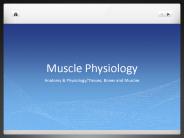Muscle fiber arrangement - PowerPoint PPT Presentation
1 / 12
Title: Muscle fiber arrangement
1
Muscle fiber arrangement
- Skeletal Muscle fibers arrange in bundles- called
fascicles. - Within a fascicle, all muscle fibers are parallel
to each other. - Fascicular arrangement affects a muscle power
range of motion - Longer fibers have greater range of motion
cover greater distance - Short muscles with higher cross-sectional
- area have more force
2
(No Transcript)
3
Fascicle arrangement
- There are 5 patterns of fascicle organization.
(Arrangement of fibers relative to axis of force
generation) - Parallel muscles. The fascicles run parallel to
the long axis of the muscle. - e.g. Stylohyoid muscle
- Fusiform or spindle-shapedmuscle tapers toward
tendons - e.g. Digastric muscle
- Triangular (convergent) muscles. The fascicles
converge on a common tendon. appear fan shaped
like pectoralis major. - Circular muscles. The fascicles are
concentrically arranged around an opening. - These muscles are also called sphincters.
When they contract the diameter of the opening
they surround decreases. Orbicularis oculi
muscle, Orbicularis oris of the mouth is an
example of a circular muscle
4
(No Transcript)
5
Pennate Fiber architecture
- Pennate means feather which the orientation of
these fibers resemble. - pennate fiber arrangement at an angle to the
longitudinal axis of the muscle, - unipennate extnesor digitorum longous
- bipennate rectus femoris
- multipennate deltoid muscle
6
(No Transcript)
7
Coordination within Muscle group
- Prime mover or agonist contract to initiate an
action. - Antagonist act against the effect of the prime
mover - Synergist a muscle acts as a synergist when it
prevents the unwanted action of another muscle. - Fixators stabilize the origin of the prime mover
8
Compartment muscle groups
- In the limbs, a compartment is a group of
skeletal muscles, along with their blood vessels
nerves, that have a common function. - Anterior or flexor compartment
- Posterior or extensor compartment
9
(No Transcript)
10
NERVE SUPPLY OF MUSCLES
- Muscles have both motor and sensory nerve
endings. - The main motor endings are large myelinated
nerves that connect to the muscle fibers at motor
end plates (MEP) - Motor units A motor neuron muscle fibers it
stimulate is called a motor unit. - Sensory nerves of muscles
- End in receptors within the muscle or its tendon
and provide feedback about muscle tension and
joint position (proprioception). Some participate
in reflexes. - Neuromuscular junction synapse between muscle
motor neuron
11
Muscle Tone
- Muscle tone is the continuous and passive partial
contraction of the muscles. It helps maintain
posture keep muscle firm. - Hypotonia decreased muscle tone (flaccid
muscles) - Hypertonia increased muscle tone, expressed in 2
ways - 1. spasticity- increased tendon reflexes.
- 2. rigidity- tendon reflexes are not affected
12
Aging Skeletal Muscle
- Slow progressive loss of skeletal muscle mass
at about 30 years of age - Cause decline activity
- Slow muscle reflexes
- Aerobic activities































